Jason Cho a.k.a. jcho documented a Brown Shrike (Lanius cristatus) catching a long-horned grasshopper (F: Tettigoniidae) and systematically preparing its prey before eating it.
From its perch it spotted the grasshopper about 20 metres away in another tree. The bird immediately flew off and seized the prey with its left talons (above left). It remained in the near vertical perch, the right foot clutching firmly on the branch and the lower leg (tarsometatarsus) of the left foot against the branches, as the toes were tightly gripping the prey.
The wings were the first to be dismembered (above right). Next, the gut or alimentary canal was ripped off and dropped to the ground (below left). Only then did it swallow what was left of the prey (below right).
Once it finished its meal, it flew back to its original perch, gaped widely (below left) and preened (below right) before singing a song.
Note: With many other birds, grasshoppers are eaten without being dismembered, most probably they are very much smaller than this specimen.
Images by Jason Cho.
This post is a cooperative effort between NaturePixels.org and BESG to bring the study of bird behaviour through photography to a wider audience.


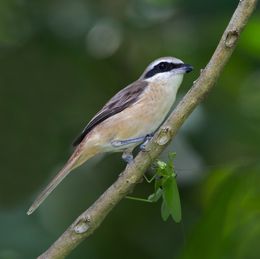

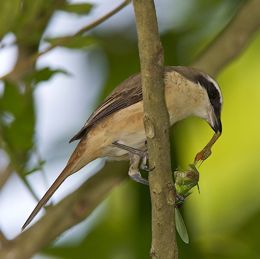
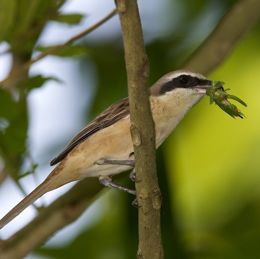
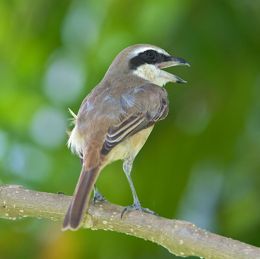
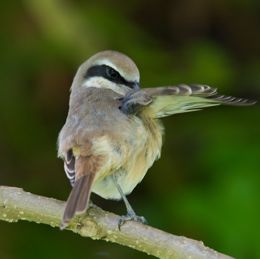







3 Responses
Looking at the pictures of the shrike dismembering a grasshopper set me thinking about the wasteful manner in which some birds eat. I am putting up this post in the hope that readers can contribute ideas and shed some light on the matter.
Unlike the shrike, some insect eating birds are terribly inefficient. Though most of my observations were made in aviaries, I have noticed such behaviour in the wild too.
When they encounter an insect too large to swallow in one gulp, such birds will grab the prey by whatever part available, then go to the ground and start thrashing it.
Very often, the leg or other part that the bird was holding comes off, and the still alive and very mobile insect gets thrown some distance away.
I believe that the escape rate would be high in the wild.
My comments are directed primarily at the true thrush family, (shamas and magpie robins) but are also applicable to laughing thrushes.
These birds usually take large prey to the ground. It would be relatively easy for the birds to step on their prey while assaulting it with their beaks, the way raptors do. But in the last 45 years, when I have almost never been without a shama or a magpie robin in my aviaries, I have never, never, seen one of them step on their prey to prevent escape.
This leads me to the assumption that in nature the true thrushes tend to feed on worms and smaller insects which they can swallow in one gulp. Would anybody have data to confirm this?
Taking the discussion further, though orioles, leaf birds, fairy blue birds and bulbuls also do not use their feet to restrain prey, they are much more efficient in dealing with large insects and caterpillars.
When one of these latter species grabs large prey, they manipulate it in their beaks until they get a good grip. Then they hammer it against a branch to soften it up.
These birds will not let go, but chew the prey from end to end, then start all over again. Only when the prey has been reduced to a soft sac of tissue in a flexible and broken exoskeleton will the bird swallow it.
I certainly look forward to hearing from anyone who can throw some more light on this subject.
What a great series! I have seen a shrike impale its prey, but not this.
One of my fellow naturalists here saw a Kingfisher raid an entire hatch of keelback baby snakes!
http://madraswanderer.blogspot.com/search/label/Vedanthangal